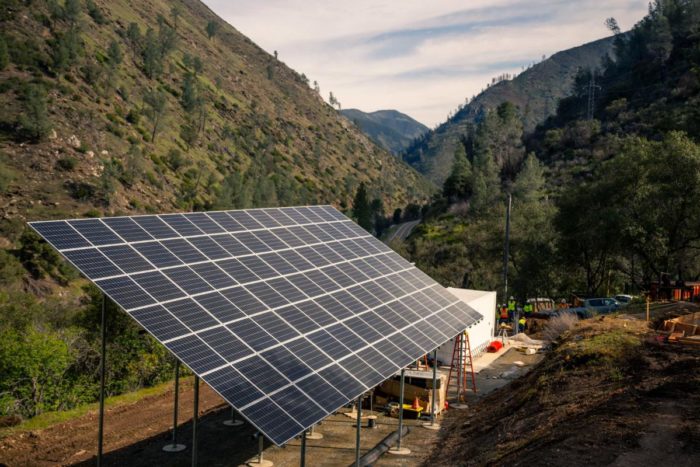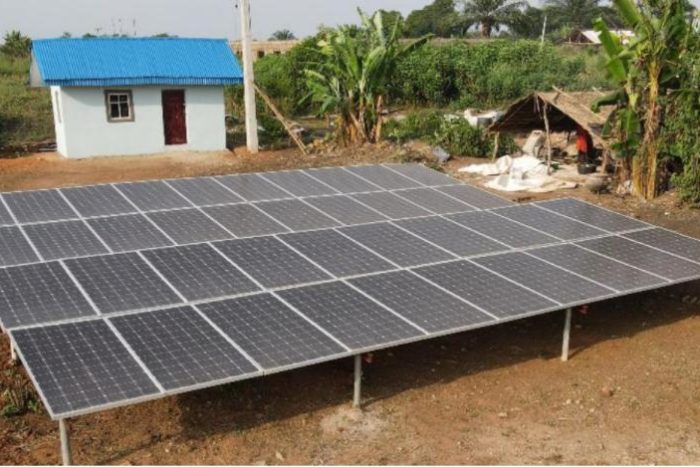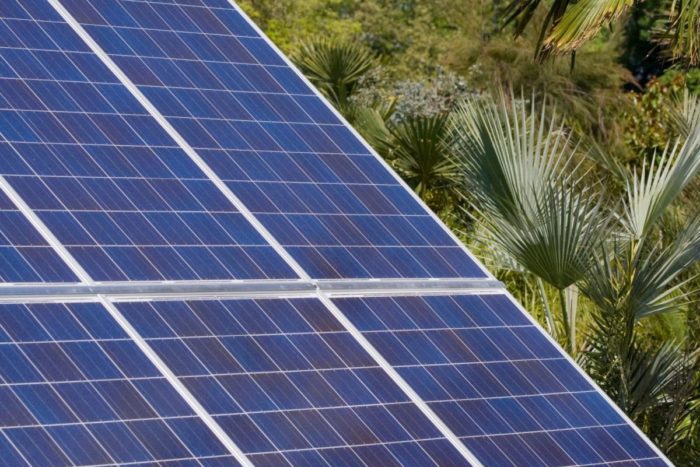Rather than rebuild distribution lines damaged by fire, PG&E is working with BoxPower to install a renewables-based microgrid to provide clean, resilient power for customers in Briceburg, California. The solar + storage system is the first of 20 proposed for development through PG&E’s new Remote Grid Initiative.
Laura Sanchez
Electric Cooking Can Improve Lives, Reduce Emissions, and Boost Solar-Powered Microgrids
A research project in rural Haiti demonstrates the effectiveness of electric cooking technologies powered by solar microgrids to improve the quality of life for community members while generating new revenue streams and opportunities for energy access providers.
Nigerian Minigrid Reveals Transformative Power of Access to Clean Energy
When Ashipa Electric installed a solar + storage-based mini-grid in an agrarian community in Nigeria, team leaders expected the system to lower power costs and reduce carbon emissions. But by offering residents access to clean, cost-effective energy, the hybrid system also revitalized the economy, elevated quality of life, and produced environmental benefits beyond all expectations.
U.S. Bill to Create a Cleaner Energy Future with Microgrids
Decarbonization has emerged as a national priority in 2021. Newly proposed legislative measures suggest that for the microgrid industry, that could mean more supportive policies and increased project funding.
An Industrial Microgrid in Costa Rica Offers Cost-Reduction and a Path to Carbon-Neutrality
A hybrid energy system at a manufacturing facility not only helps reduce energy costs and emissions, but also has far-reaching carbon reduction benefits, and positions Costa Rica as a leader in the fight against climate change.
Results-Based Financing Models Provide Path Forward for Mini-Grids in Africa
Mini-grids could provide energy access to the approximately 580 million people without power in Africa while fulfilling decarbonization and climate goals. However, financing these projects often proves challenging. In order to secure funding, project developers are increasingly looking to results-based models.
Texas Energy Crisis Strengthens Case for Microgrids
Catastrophic events such as the one in Texas last week demonstrate the value of energy networks that include many small, distributed power systems to provide power when the larger network is unable to.
Converting Diesel Mini-grids to Solar Makes Kenya More Sustainable
As Kenya’s population and economy grow, energy providers are leveraging renewable resources and converting existing diesel-powered mini-grids to hybrid systems. Kenya’s electric utility, Kenya Power and Lighting Company recently issued a proposal to add solar and wind power generation to 23 diesel mini-grids in operation across the country.
Unearthing Value – Microgrids Help Mines Come Clean
Renewables-based microgrids are becoming increasingly valuable for mining businesses worldwide as they offer an economically viable pathway toward decarbonization.
California’s New Rules Support Resiliency
California’s pioneering development of new microgrid tariffs will not only create a revenue stream for microgrids and advance related technologies, it is likely to serve as a model for other states.
A Microgrid Pilot Program in Wisconsin Aims to Boost Resilience
With resiliency in mind, a Wisconsin utility has proposed a novel microgrid pilot program that will pave the way for 22 microgrid projects and ultimately offer energy consumers access to cleaner, more reliable power.
The Need for Operational Resilience Drives Microgrid Innovation
A Colorado car dealership experienced several prolonged power outages during business hours each year. The lost business was consequential, so it installed an innovative grid-tied, solar + storage microgrid that today provides a myriad of benefits.
Ripple Effect: An Educational Microgrid in Indonesia With Far-Reaching Benefits
Access to energy is a challenge for inhabitants of remote islands in Maluku Province, Indonesia. But a new campus mini-grid lab will soon offer engineering students practical experience that could produce a groundswell of interest in renewable energy and provide more villages with power.
Retail Power: Solar-Powered Shopping Centers Provide Cost Savings and Clean Energy
A rising number of shopping mall owners in Australia are turning the rooftops of commercial spaces into power plants with on-site solar arrays and energy storage. These hybrid systems allow owners to provide tenants with cheaper, cleaner power.
Building Green: Powering Construction Sites with Renewable Energy
Construction sites, known for their high energy requirements, are major producers of greenhouse gas emissions. Faced with a surge in urban construction and increasingly stringent carbon reduction regulations worldwide, builders are turning to renewables-based hybrid systems to power their sites.
A Positive Charge for Energy Storage
Today energy storage technology is recognized as an integral part of the transition to clean energy. In this article, we explore battery technology and safety advancements, as well as the market’s rapid growth and its impact on microgrids and hybrid power systems.
Top 10 Microgrid News Stories of 2020
As 2020 comes to a close, we’ve curated a collection of the most interesting and informative articles published on Microgrid News this year to inform your design projects and inspire your vision for 2021.
EarthSpark International Receives OPEC Fund’s Annual Award for Development
EarthSpark International has been named the recipient of the 2020 OPEC Fund Annual Award for Development. The award recognizes EarthSpark’s innovative solutions addressing energy access and climate-related issues in Haiti.
Feasibility Studies Instrumental in Success of 5 Municipal Microgrid Projects in California
The value of proving economic and technical viability was demonstrated by the City of Camarillo recently, when, based on a positive feasibility study, council members voted unanimously to move forward with the design of hybrid solar microgrids at five of its facilities.
Exploring Efficiencies at the Water-Energy Nexus: Rottnest Island’s Innovative Hybrid Energy System
Faced with the challenge of utilizing hybrid renewable energy to produce enough electricity and potable water for the island’s large annual influx of visitors, the Rottnest Island Authority found a path to success through an innovative approach to demand management at the water-energy nexus.
Microgrid Funding Opportunities Arise as Maryland Emerges as Key State for Development of Hybrid Power
Funding opportunities from the Maryland Energy Administration’s Resilient Maryland grant program have jumpstarted projects throughout the state. As a result, Maryland has emerged as a key state for microgrid project development. The 2021 grant deadline is approaching.
Renewable Energy Powers an Arctic Village: Ancient Traditions and Clean Technology
Developing a microgrid in the Yukon’s extreme North is a challenge of epic proportions. A landmark power purchase agreement, extraordinary system engineering, and a unique pitched panel design will allow the village of Old Crow to reduce its diesel consumption by over 50,000 gallons per year.
HOMER International Microgrid Conference Identifies Technological Advances, Policy Shifts, and the Industry’s Path Forward
The 8th Annual HOMER International Microgrid Conference attracted record-breaking participation and international representation, as well as an extraordinary selection of presentations by industry leaders. Session recordings are now available.
Looking to the Past to Predict the Future of Microgrid Markets
By studying historic drivers and evaluating current market indicators, Wood Mackenzie researcher Isaac Maze-Rothstein has gathered key insights related to microgrid markets in both the US and Kenya. He and colleague Benjamin Attia have mapped out an overview of what the future may look like for these markets. They will present their findings at the 8th annual HOMER International Microgrid Conference on October 12.
Groundbreaking FERC Order 2222 Opens Energy Markets to DERs
The Federal Energy Regulatory Commission (FERC) recently approved a landmark ruling that enables distributed energy resource aggregators to compete in regional wholesale energy markets. The ruling is expected to create new revenue opportunities for owners of solar, batteries, EVs, and other DERs.
Top 5 Reasons to Attend HIMC 2020 and Join the Microgrid Revolution
The global microgrid market is experiencing unprecedented growth. Learn how you can capitalize on this expansion and use it to propel your business forward at the 8th annual HOMER International Microgrid Conference. The event is 100% virtual and free to attend.
Foundational Support: Vallecito Energy Storage Resilience Project Lays the Groundwork for a Larger Renewables-Based System
An exciting energy storage installation in the Goleta Load Pocket, a highly vulnerable 70-mile transmission area in Southern California, will provide resilience in the form of 40 MWh of utility-scale energy storage. The Vallecito Energy Storage Resilience project will not only provide an energy storage foundation for a future community microgrid, but it lays the groundwork for a more resilient energy network in a region hard-hit by natural disasters.
HOMER Training: The Roadmap to Better System Modeling and a Sustainable Future
HOMER Energy by UL’s educational curriculum covers all of the essential skills needed to analyze distributed generation and microgrid projects and get the most out of the software. Senior Engineer, Head of Professional Services, and Lead Trainer Aleph Baumbach and his team tailor sessions to address each audience’s needs and support individual projects with hands-on training. Baumbach’s enthusiasm for developing a better path to sustainability is infectious.
Tandem Technologies: Pairing Diesel Generators with Renewable Resources
Pairing diesel generators with renewable resources in energy systems can be an effective cost-reduction strategy when generators are operated flexibly. Dr. James Hamilton shares insights he’s gathered while developing remote, off-grid projects in Australia.
Mind the (Charging) Gap: Electric truck fleets are set to expand exponentially. But not without robust charging infrastructure.
Analysts forecast a dramatic rise in the number of e-trucks on the road by 2025, which can significantly reduce greenhouse gas emissions and support air quality goals. But addressing the question of how to meet the high energy demand and infrastructure needs of e-trucking fleets is critical. On-site, renewable generation offers a solution.





























